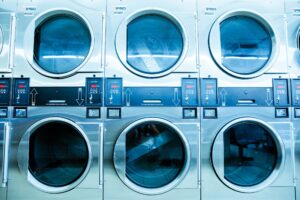[playht_player width=”100%” height=”90px” voice=”en-US-DavisNeural”]
Introduction: Common Problems with Washing Machines
Washing machines are an essential appliance in most households, making laundry chores much more convenient. However, like any other machine, they can experience problems from time to time. These issues can range from minor inconveniences to major malfunctions that require professional repair. It is important to address these problems promptly to prevent further damage and ensure the longevity of your washing machine.
Leaks: Causes and Solutions
One of the most common problems with washing machines is leaks. Leaks can occur for a variety of reasons, including worn-out hoses, faulty seals, or a damaged water pump. To identify the source of the leak, start by checking the hoses and connections for any signs of damage or loose fittings. If the hoses are in good condition, inspect the seals around the door or lid of the washing machine. If you notice any cracks or gaps, they may need to be replaced.
To fix a leak in your washing machine, you may need to replace faulty parts. This could include replacing worn-out hoses or seals, or even replacing the water pump if it is damaged. It is important to consult your washing machine’s manual or contact a professional technician for guidance on how to properly replace these parts. Ignoring a leak can lead to further damage to your washing machine and potentially cause water damage to your home.
Loud Noises: Identifying the Source of the Problem
Another common problem with washing machines is loud noises during operation. These noises can be caused by a variety of factors, including worn-out bearings, loose belts, or objects stuck in the drum. To identify the source of the noise, start by running an empty cycle and listening for any unusual sounds. If you hear a loud banging noise, it could indicate that the drum is unbalanced or that there is an object stuck in it.
To fix the problem of loud noises in your washing machine, you may need to replace worn-out parts such as bearings or belts. If there is an object stuck in the drum, you will need to remove it carefully to avoid causing further damage. It is important to consult your washing machine’s manual or contact a professional technician for guidance on how to properly replace these parts or remove objects from the drum.
Clogged Drains: How to Fix Them
Clogged drains are another common issue with washing machines. This can be caused by a buildup of lint, debris, or even small objects that have been left in pockets. To unclog the drain, start by disconnecting the washing machine from the power source and removing any excess water from the drum. Then, locate the drain pump filter, which is usually located at the front or bottom of the machine. Remove the filter and clean it thoroughly, removing any debris or lint that may be causing the clog.
To prevent future clogs in your washing machine’s drain, it is important to clean the filter regularly and avoid washing items with large amounts of lint or debris. Additionally, emptying pockets before washing can help prevent small objects from causing clogs. Regular maintenance and cleaning of your washing machine can also help prevent clogs and keep it running smoothly.
Unbalanced Loads: Preventing Damage to Your Washer
Unbalanced loads are another common problem with washing machines. This can occur when the laundry is not distributed evenly in the drum, causing it to become unbalanced during the spin cycle. This can lead to excessive vibrations and potential damage to your washing machine. To prevent unbalanced loads, start by evenly distributing the laundry in the drum before starting a cycle. Avoid overloading the machine and make sure to follow the manufacturer’s guidelines for load capacity.
If you notice that your washing machine is consistently experiencing unbalanced loads, there may be an issue with the suspension system or leveling of the machine. In this case, it may be necessary to redistribute the load manually or adjust the leveling feet of the machine. If the problem persists, it is recommended to contact a professional technician for further inspection and repair.
Faulty Belts: Replacing and Repairing
Faulty belts are another common issue with washing machines. The belts in a washing machine are responsible for transferring power from the motor to the drum and other components. Over time, these belts can become worn-out or damaged, leading to issues such as the drum not spinning or excessive noise during operation. To replace or repair a faulty belt, start by disconnecting the washing machine from the power source and removing the back panel to access the belt.
To prevent future belt issues, it is important to avoid overloading the machine and ensure that the load is evenly distributed in the drum. Regular maintenance and cleaning of your washing machine can also help prevent belt issues by reducing the buildup of debris or lint that can cause damage.
Electrical Issues: Safety Precautions and Troubleshooting Tips
Electrical issues can also occur in washing machines, which can be potentially dangerous if not handled properly. Common electrical problems include blown fuses, faulty wiring, or issues with the control board. When troubleshooting electrical problems in your washing machine, it is important to take safety precautions such as disconnecting the machine from the power source and wearing protective gloves.
To fix electrical issues in your washing machine, start by checking the fuses and circuit breakers to ensure they are not blown or tripped. If you suspect an issue with the wiring, it is recommended to contact a professional technician for further inspection and repair. It is important to avoid attempting to repair electrical issues yourself unless you have proper knowledge and experience in handling electrical systems.
Detergent Buildup: Cleaning Your Washer’s Interior
Detergent buildup is a common issue in washing machines, especially if you use excessive amounts of detergent or if you frequently use liquid detergents. This buildup can cause a variety of problems, including foul odors, reduced cleaning performance, and even damage to the machine. To clean the interior of your washing machine, start by running a hot water cycle with vinegar or a specialized washing machine cleaner. This will help dissolve and remove any detergent buildup.
To prevent future detergent buildup, it is important to follow the manufacturer’s guidelines for detergent usage and avoid using excessive amounts. Additionally, regularly cleaning the drum and other components of your washing machine can help prevent buildup and keep it running efficiently.
Water Supply Problems: Checking Hoses and Valves
Water supply problems are another common issue with washing machines. This can include issues such as low water pressure, leaks in the hoses or valves, or even a faulty water inlet valve. To check for water supply problems, start by ensuring that the water supply to the machine is turned on and that there are no issues with the water pressure in your home. Then, inspect the hoses and valves for any signs of leaks or damage.
To fix water supply problems in your washing machine, you may need to replace faulty hoses or valves. It is important to consult your washing machine’s manual or contact a professional technician for guidance on how to properly replace these parts.
Will the Troubleshooting Tips for Washers Also Help Fix Common Dryer Problems?
Yes, the troubleshooting tips for washers may also be useful to help fix common dryer problems. Sometimes, common dryer problems fix may include checking for clogged vents, ensuring the proper level of airflow, and cleaning the lint filter regularly. These tips can help address many issues with dryers. In addition to dryer maintenance, homeowners should also pay attention to troubleshooting washer leaks, as these can lead to water damage and mold growth. Regularly inspecting hoses and connections can prevent potential leaks and improve overall efficiency. Taking proactive steps can save both time and money in the long run. Additionally, having the right washer repair troubleshooting tools on hand can make diagnosing and fixing issues much simpler. Whether it’s a multimeter for electrical problems or specific socket sets for tightening connections, being prepared can streamline the repair process. Homeowners should consider investing in a basic toolkit specifically designed for appliance maintenance to effectively tackle both washer and dryer issues.
When to Call a Professional: Signs You Need Expert Help
While many common problems with washing machines can be fixed by following troubleshooting steps or replacing faulty parts, there are certain signs that indicate you need professional help. These signs include persistent leaks, loud noises that cannot be identified or fixed, electrical issues that pose a safety risk, or any other major malfunctions that you are unable to resolve on your own.
When hiring a professional technician to repair your washing machine, it is important to choose a reputable service provider. Look for technicians who are certified and experienced in repairing washing machines. Additionally, read reviews and ask for recommendations from friends or family to ensure that you are hiring a reliable and trustworthy technician.
Conclusion:
In conclusion, washing machines can experience a variety of common problems that can range from minor inconveniences to major malfunctions. It is important to address these problems promptly to prevent further damage and ensure the longevity of your washing machine. By following the troubleshooting steps outlined in this article and practicing regular maintenance, you can prevent many common issues with your washing machine and keep it running smoothly for years to come.



